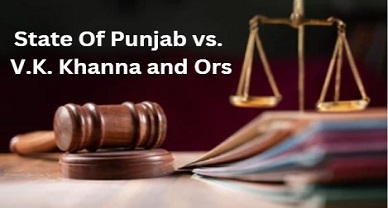Tarapada De and 99 Others v. State of West Bengal
Introduction
The decision of the High Court in Calcutta, which denied the appellants’ habeas corpus petitions, was appealed under article 132 of the Indian Constitution in the present matter. Under the Bengal Criminal Law Amendment Act, 1930 (hereinafter referred to as BCLAA, 1930) a significant number of people were detained. It was being contested in the High Court as to the validity of BCLAA, 1930. On February 26, 1950, detention orders issued under the Preventive Detention Act of 1950 were served upon them. In the meantime, the Preventive Detention Act, 1950 (hereinafter referred to as PDA, 1950) had been passed on 26 February, 1950. They were served with the grounds for detention on March 14 and then served with “supplementary grounds” by the government on July 16 which built upon the grounds that were used on March 14. For this reason, the Appellants of the instant case approached the Calcutta High Court (hereinafter referred to as HC) claiming that detention orders were invalid.
Issue
Upon consideration of all the facts of the case and arguments presented by the parties, the Apex Court framed and delved into the following legal issues:
Issue 1:
Whether the grounds for detention were communicated “as soon as may be”?
Issue 2:
Whether the contents of the second communication described as “supplementary grounds” amount to fresh grounds?
Issue 3:
Whether the grounds being allegedly vague would be construed as irrelevant?
Issue 4:
Whether there was any bad faith on the part of the authorities in making a signification number of fresh detention orders?
Rules
Article 22(5), Constitution of India
Bengal Criminal Law Amendment Act, 1930
Section 491, Criminal Procedure Code, 1898
Section 16, Indian Criminal Amendment Act (14 of 1908)
Section 3, Preventive Detention Act, 1950 (4 of 1950)
Section 7, Preventive Detention Act, 1950 (4 of 1950)[1]
Analysis
COMPLIANCE OF PROCEDURE PROVIDED UNDER ARTICLE 22(5) AND SECTION 7 OF PDA, 1950
Article 22(5)[2] of the COI stipulates that if someone is being held in accordance with a law that permits preventative detention, the authority issuing the order must notify the person as quickly as possible about the reason for the order and provide him with the earliest opportunity to challenge it. If someone’s personal liberty is in jeopardy, they have the right to make a representation.[3] For this reason, information about the arrest should be communicated in a way that helps the detainee comprehend the circumstances behind his detention. The need of allowing the detenu to voice their opinions has been emphasised. It not only provides the opportunity to produce a representation, but it also ensures that the representation is taken into consideration and handled quickly to maintain its meaning and purpose.[4]
It was the case of the Appellants that the grounds dated 14 March 1950 were not communicated to them “as soon as may be” and hence were not in compliance with Article 22(5)[5] of the COI.
The words “as soon as may be” cannot be quantified into a definite period of time which can be laid down as reasonable in all cases.[6] Thus, there can be no hard and fast rule as to the measurement of reasonable time and such determination shall depend upon the facts[7] and nature of each case.
[Image Sources: Shutterstock]
Nonetheless, taking regard of the peculiar tangent of the case, the Apex Court while reaffirming the observation of the HC in this regard opined that PDA, 1950 was passed by the Parliament in the last week of February in the year 1950 and the detention orders were served on 26 February, 1950. The argument of the appellants was rejected by the Apex Court because to the government’s unexpected need to handle a big volume of cases in a single day. The remaining aspects, namely the second communication (referred to as supplemental grounds), which are either additional incidents that, when combined with the facts mentioned or indicated in the grounds previously conveyed, lead to the same conclusion of fact (which is the ground furnished in the first instance) or are simply details of the facts mentioned or indicated in the first grounds supplied, are on a different footing. In accordance with the first portion of article 22(5), they are not new grounds.[8]
Supplementary Grounds Not Fresh
The Apex Court opined that the description of the contents of the second communication as “supplementary grounds” does not necessarily make them additional or new grounds because upon examination of the contents of the later communication, it was found that merely the details of the second heads of grounds were furnished to the appropriate appellant.
Vague Grounds V. Irrelevant Grounds
There is a distinction between irrelevant and ambiguous ground. They are not in equal standing. Even later, details on ambiguous grounds may be provided to demonstrate the grounds’ justification.[9] The Apex Court was to examine whether the grounds were sufficient to allow the individual in custody to present a case as soon as possible. The Apex Court stated that it upholds the HC’s conclusion that the communication of the grounds on March 14, 1950, and the following communication dated July 16, 1950, did not violate the procedural requirement of providing the detained person with the earliest chance to make representation.
Application of Mind
When using discretionary power, one must do so for appropriate reasons or considerations. An arbitrary judgement taints the decision if all pertinent factors are disregarded or if irrelevant considerations are accepted.[10] It is a well-established principle that a statutory authority must form an opinion on any matter objectively based on pertinent reasons.[11] There is an implicit duty to consider relevant and immediate issues whenever a decision-making function is left to the subjective satisfaction of a statutory functionary.[12] In this instance, there was no official duty breach that would have demonstrated bad faith on the part of the authorities.
Conclusion
The Apex Court dismissed the appeal after carefully examining every facet of the present case. The Apex Court reaffirmed the HC’s ruling in the decision that examined conformity with the procedure provided in Section 7 of the Preventive Detention Act, 1950 and Article 22(5) of the COI. The appellants’ main point of dispute in this case concerned when the grounds were communicated. As required by Article 22(5), the appellants contended that these grounds were not communicated “as soon as may be”. The Apex Court, however, dismissed this avermentt, acknowledging that the word “as soon as may be” does not lend itself to a strict deadline that applies to everyone. The Court emphasised the government’s abrupt requirement to handle a big number of cases on a single day, while also taking into account the unusual circumstances surrounding the passing of PDA, 1950 by the Parliament. The Apex Court also looked into what the additional grounds that were conveyed on July 16, 1950 were like. The court found that although these grounds included specific information on the second category of grounds, they did not represent new or additional grounds. Making this distinction was essential to determining whether Article 22(5) was being followed. A significant aspect of the discussion was about the distinction between vague and irrelevant grounds. The Apex Court stressed that although specifics on ambiguous grounds can be provided thereafter to support the detention, their non-supply could result in a breach of Article 22 (5). The Apex Court stressed that although specifics on ambiguous grounds can be provided thereafter to support the detention, their non-supply could result in a breach of Article 22 (5). The most important factor was still whether there were enough grounds to give the person in custody the earliest chance to be represented. In order to conclude that there was no duty breach on the side of the authorities and to refute any claims of bad faith in the use of discretionary powers, the Apex Court also touched on the more general principles of administrative discretion.
Bibliography
CASES
Dunlop India Ltd v UOI AIR 1977 SC 597 (India)
Swastik Rubber Products Ltd. v Poona Municipality AIR 1981 SC 2022 (India)
Union of India v Jesus Sales Corporation AIR 1996 SC 1509 (India)
Shalini Soni v Union of India AIR 1981 SC 431 (India)
The State of Bombay v Atma Ram Sridhar Vaidya, A.I.R. 1951 S.C. 157 (India)
BOOKS
5 DD Basu, Commentary on the Constitution of India (9th ed.)
B P Banerjee, Writ Remedies-Remediable Rights under Public Law (Including High Court Rules and Guidelines for Drafting Writ Petitions (7th ed. 2016)
JOURNALS
Alan Gledhill, Life And Liberty In The First Ten Years Of Republican India, 2 JILI, 241, 251 (1960).
M.S. Malik, Preventive Detention and Human Rights, 3 NALSAR L.R. 49, 52-53, (2006-07).
B.P. Srivastava, Right Against Arbitrary Arrest And Detention Under Article 9 Of The Convenant As Recognized And Protected Under The Indian Law, 11 JILI 29, 39 (1969).
STATUTE
Article 22(5), Constitution of India
Bengal Criminal Law Amendment Act, 1930
Section 491, Criminal Procedure Code, 1898
Section 16, Indian Criminal Amendment Act (14 of 1908)
Section 3, Preventive Detention Act, 1950 (4 of 1950)
Section 7, Preventive Detention Act, 1950 (4 of 1950)
Author: Sonakshi Pandey, in case of any queries please contact/write back to us at support@ipandlegalfilings.com or IP & Legal Filing.
[1] Preventive Detention Act, 1950, No. 4, Acts of Parliament, 1950 (India)
[2] INDIA CONST. art 22, cl. 5
[3] Alan Gledhill, Life And Liberty In The First Ten Years Of Republican India, 2 JILI, 241, 251 (1960).
[4] M.S. Malik, Preventive Detention and Human Rights, 3 NALSAR L.R. 49, 52-53, (2006-07).
[5] INDIA CONST. art 22, cl. 5
[6] B.P. Srivastava, Right Against Arbitrary Arrest And Detention Under Article 9 Of The Convenant As Recognized And Protected Under The Indian Law, 11 JILI 29, 39 (1969).
[7] 5 DD Basu, Commentary on the Constitution of India (9th ed.)
[8] The State of Bombay v Atma Ram Sridhar Vaidya, A.I.R. 1951 S.C. 157 (India).
[9] B P Banerjee, Writ Remedies-Remediable Rights under Public Law (Including High Court Rules and Guidelines for Drafting Writ Petitions (7th ed. 2016)
[10] Swastik Rubber Products Ltd. v Poona Municipality, AIR 1981 SC 2022 (India).
[11] Union of India v Jesus Sales Corporation, AIR 1996 SC 1509 (India).
[12] Shalini Soni v Union of India, AIR 1981 SC 431(India).


